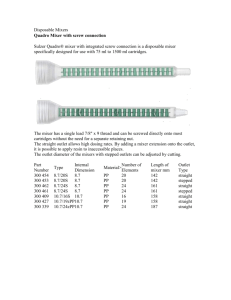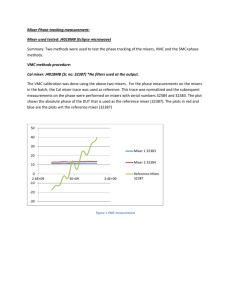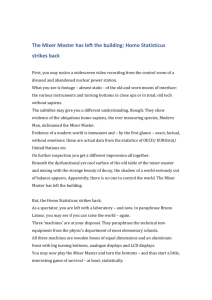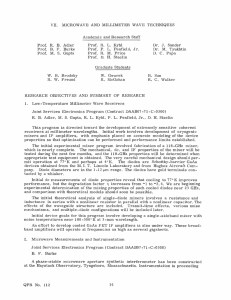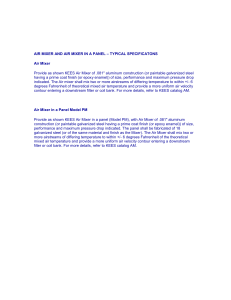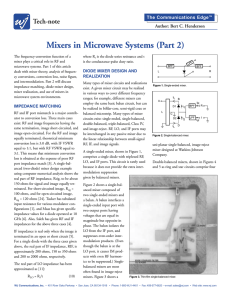VIII. SOLID-STATE MICROWAVE ELECTRONICS
advertisement
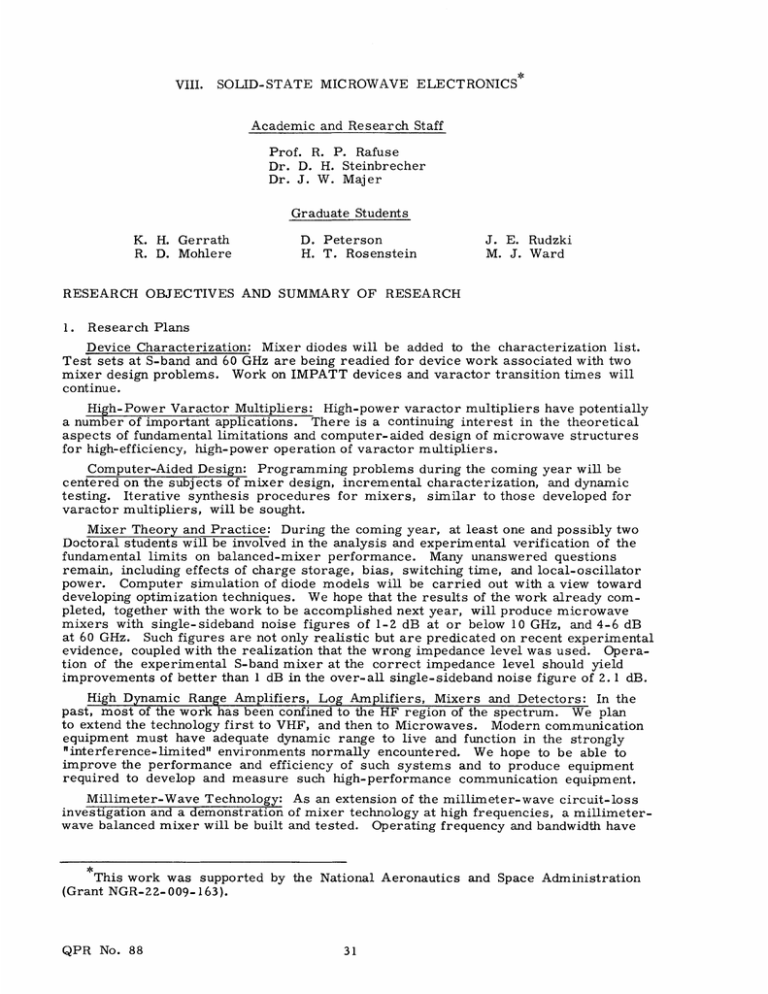
VIII. SOLID-STATE MICROWAVE ELECTRONICS Academic and Research Staff Prof. R. P. Rafuse Dr. D. H. Steinbrecher Dr. J. W. Majer Graduate Students K. H. Gerrath R. D. Mohlere D. Peterson H. T. Rosenstein J. E. Rudzki M. J. Ward RESEARCH OBJECTIVES AND SUMMARY OF RESEARCH 1. Research Plans Device Characterization: Mixer diodes will be added to the characterization list. Test sets at S-band and 60 GHz are being readied for device work associated with two mixer design problems. Work on IMPATT devices and varactor transition times will continue. High-Power Varactor Multipliers: High-power varactor multipliers have potentially a number of important applications. There is a continuing interest in the theoretical aspects of fundamental limitations and computer-aided design of microwave structures for high-efficiency, high-power operation of varactor multipliers. Computer-Aided Design: Programming problems during the coming year will be centered on the subjects of mixer design, incremental characterization, and dynamic testing. Iterative synthesis procedures for mixers, similar to those developed for varactor multipliers, will be sought. Mixer Theory and Practice: During the coming year, at least one and possibly two Doctoral students will be involved in the analysis and experimental verification of the fundamental limits on balanced-mixer performance. Many unanswered questions remain, including effects of charge storage, bias, switching time, and local-oscillator power. Computer simulation of diode models will be carried out with a view toward developing optimization techniques. We hope that the results of the work already completed, together with the work to be accomplished next year, will produce microwave mixers with single-sideband noise figures of 1-2 dB at or below 10 GHz, and 4-6 dB at 60 GHz. Such figures are not only realistic but are predicated on recent experimental evidence, coupled with the realization that the wrong impedance level was used. Operation of the experimental S-band mixer at the correct impedance level should yield improvements of better than 1 dB in the over-all single-sideband noise figure of 2. 1 dB. High Dynamic Range Amplifiers, Log Amplifiers, Mixers and Detectors: In the past, most of the work has been confined to the HF region of the spectrum. We plan to extend the technology first to VHF, and then to Microwaves. Modern communication equipment must have adequate dynamic range to live and function in the strongly "interference-limited" environments normally encountered. We hope to be able to improve the performance and efficiency of such systems and to produce equipment required to develop and measure such high-performance communication equipment. Millimeter-Wave Technology: As an extension of the millimeter-wave circuit-loss investigation and a demonstration of mixer technology at high frequencies, a millimeterwave balanced mixer will be built and tested. Operating frequency and bandwidth have *This work was supported by the National Aeronautics and Space Administration (Grant NGR-22-009-163). QPR No. 88 (VIII. SOLID-STATE MICROWAVE ELECTRONICS) not been selected, but present scientific interests indicate that 60 GHz will be considered seriously. 2. Work Completed Device Characterization: Measurements of IMPATT oscillators at X-band and Ku-band have been completed. A detailed analysis of these microwave measurements is now under way. The most interesting feature of the latest data (on Varian, Bomac Division, devices) is the very large reactance variations taking place under oscillating conditions. Complete characterization of the dynamic impedance of an avalanching junction may predict that imbedding networks that include harmonic terminations will improve the efficiency of IMPATT sources. Transition-time measurements on punch-through varactors have indicated the possible presence of a dynamic capacitance-voltage relationship that is a function of drive level. In fact, certain diodes appear to exhibit hysteresis in their capacitance- charge characteristic. Isolation of the hysteresis-producing mechanism and its characterization will permit improved design of high-power varactors. High-Power Varactor Multipliers: We have continued the device characterization and computer-aided design portions of this effort. Most of the results have been published or reported in individual technical exchange sessions with industry. Some of the results of our studies have influenced design and development of high-power, solid-state transmitters in both Government and Industry. Computer-Aided Design: Composite programs developed during the present reporting period deal with IMPATT-diode data reduction and analysis, transition-time calculations for punch-through varactors, microwave measurement processing, and many other areas of current research. Many subprograms have been compiled into a function library that permits simple analysis and design programming in the microwave field. Examples of library functions are routines that transform impedance through generalized coupling networks, do least-mean-square fits of data to commonly occurring functionals like circles and lines, and rotate, transform, and plot Smith-Chart data. Mixer Theory: Some of the major results, thus far, have been reported in a paper entitled "Low Noise and Dynamic Range in Symmetric Mixer Circuits," given by R. P. Rafuse at the Cornell University Conference on High-Frequency Power Generation and Amplification, August 30, 1967. Some of the results of a theoretical examination of balanced-mixer performance are highly promising. They indicate that high-quality Schottky-barrier mixers are capable of giving noise-figure performances not very different from those obtainable at the same frequency with the same diode cutoff frequency in an optimized parametric amplifier. As an interesting verification of the theory, a mixer constructed for the megahertz frequency range exhibited a conversion loss of less than 0. 1 dB. It is clear that fundamental advances in mixer performance are now possible if the proper design parameters are utilized. High Dynamic Range Amplifiers, Log-Amplifiers, Mixers and Detectors: A complete, phase-locked tracking receiver is now designed for the 1-28-MHz range. The receiver utilizes a balanced 4-FET mixer with a dynamic range in excess of 120 dB [defined as the signal level of the two-tone, giving a 10-dB (S+N)/N subtracted from the two-tone signal level which produces 3r d order products also with 10-dB (S+N)/N (all signals are measured in a 1-kHz bandwidth)]. Crystal-lattice filters with ultimate skirt selectivities in excess of 150 dB are being developed, together with the synchronous detectors of greater than 100-dB dynamic range. An interesting result concerns the high "product linearity" of the mixers and synchronous detectors, with the result that signal and reference signal power can be traded over more than a 100-dB range without significant change in output level or distortion products. Such a "tradeability" suggests novel, nondistorting AGC systems and a possible mechanism for producing output from the receiver proportional to the log of the signal QPR No. 88 (VIII. SOLID-STATE MICROWAVE ELECTRONICS) level over a 120-dB range. A complete phase-locked receiver is under development and first models should be under test early in 1968. Millimeter-Wave Technology: A study of loss in microwave circuits culminated in the construction of a 23. 5-GHz degenerate parametric amplifier (pumped at 47 GHz). Preliminary tests on the completed circuit, which has no tuning adjustments except for the diode bias, indicate that the measurable input-circuit loss is below 0. 08 dB. The bias tunable bandwidth appears to be over 1 GHz. Measured amplifier noise temperature is less than 50* K at room temperature. As expected, loss in millimeter-wave circuits can be eliminated by careful design and construction techniques. R. P. Rafuse QPR No. 88

